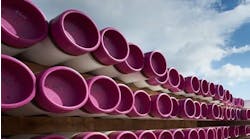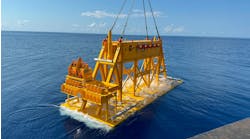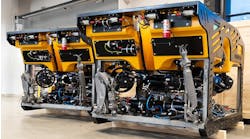History, expertise, location add to area draw
When the Norwegian government decided in 2006 to set up centers of expertise to promote the country’s business strengths in various areas, it chose Bergen as the centre of expertise for the subsea sector – and with good reason. In and around this attractive city on Norway’s west coast is a dense cluster of companies, from small to large, offering a wide range of subsea technology for the offshore oil and gas industry. The subsea cluster’s main focus is on aftermarket activities – maintenance, modification and operation.
By setting up the centers of expertise the government’s aim is to give the relevant clusters the means to access the international market while further developing their products and services. Funds are available from three sources – Innovation Norway, which promotes industrial development, the Research Council of Norway, and the Industrial Development Corp. of Norway (Siva). The lead role in facilitating operations falls to the Norwegian Center of Expertise (NCE) Subsea, which is owned by the member companies and equally funded by them and the government.
NCE Subsea.
Statoil influence
The North Sea, along with Brazil, has been a key breeding ground for the development of subsea technology. Both Statoil and Norsk Hydro - the latter until its oil and gas operations were merged with those of Statoil in 2007 - have acted as technology pushers setting challenges to the service and supply sector, many of them connected to the constant drive to improve oil recovery, says Olsen. The demanding conditions met in the North Sea mean that the products and services developed are suitable for application elsewhere around the world.
The number of companies affiliated to the NCE has constantly grown, and is now close to 100, Olsen explains. They range from leading subsea contractors such as FMC Technologies and Aker Solutions, and systems and equipment suppliers such as Framo Engineering, to smaller companies with specialist expertise offering niche products. The membership also includes educational and research organizations such as the University of Bergen, University College of Bergen, Institute of Marine Research, and Christian Michelsen Institute. The highest-profile member is Statoil itself, which in global terms is second only to Petrobras in the number of subsea trees it operates.
The Coast Center Base outside Bergen provides a major arena for subsea activity, where Statoil has its subsea tool pool, FMC its customer support for the eastern hemisphere, and Aker its subsea after-market division for the North Sea.
The Bergen cluster has grown rapidly following the establishment of the center of expertise. The number of employees in member companies rose from 2,500 in 2004 to 4,600 in 2008, while over the same period, aggregate turnover increased from $760 million to $1.95 billion.
As the shallower waters in oil and gas provinces around the world become more mature, and an ever greater proportion of exploration and production takes place in deeper waters, it is subsea facilities which provide the dominant means of production, whether tied back to a floater, a production facility on another field or even directly to shore. According to one recent survey, more than 3,000 subsea trees will be installed in the period 2009-2013, while global subsea expenditures are set to increase to $80 billion from $46 billion in the previous five-year period.
MME potential
The focus of NCE Subsea’s work is on the subsea maintenance, modifications and operations sector. There is a clear incentive for operators to make greater use of these services in order to bring recovery from subsea wells up to the level achieved from platform wells. Statoil has given a lead by setting itself the tough target of achieving 55% recovery from subsea wells.
As major parts of the North Sea, both in the UK and Norwegian sectors, move into maturity, there is a noticeable shift in spending away from new field developments towards operating and maintenance activities on producing fields. The latest survey of spending on the Norwegian continental shelf from Statistics Norway indicates operating expenditure on producing fields this year of some NOK 70 billion ($11 billion) compared with NOK 32 billion ($5.04 billion) on field development. During the downturn, the focus on Maintenance, Modification and Operation benefited many of the member companies, as spending in the brownfield market was sustained, while investments in new developments slumped last year as many projects were shelved, Olsen points out.
The dynamic process of subsea technology development has dramatically pushed back the boundaries of what is possible, transferring functions from the surface to the seabed. For example, subsea pumping and processing techniques now make it possible to separate out water from hydrocarbons on the seabed and inject it into a disposal well, while hydrocarbons can be pumped over relatively long distances. The next step is subsea gas compression, for which pilot projects are under way.
The process of subsea technology development itself creates new needs. If there is to be rotating machinery, it needs to be serviced. If wellstreams are to be pumped over long distances, an eye needs to be kept on the pipeline contents to guard against wax or hydrate formation, and on the state of the pipe walls. Condition monitoring is currently at the forefront of subsea technology development – being constantly aware of the state of the equipment allows the operator to optimize decision-making about maintenance, and perhaps to head off problems before they can develop.
Technology needs
Condition monitoring is ranked top of the list of priorities for NCE Subsea, according to Olsen. The cluster embraces many companies with technologies and products for condition monitoring. ClampOn and Roxar, for example, offer products for sand and corrosion/erosion monitoring, Framo Engineering and Roxar have products for multiphase flow measurement, while Bjørge Naxys has an acoustic system for the surveillance of subsea facilities. These are just a few of the technologies developed and delivered to the market by companies in the Bergen subsea cluster, he explains.
In 2008, a lighthouse project on subsea condition monitoring was launched that kicked off with a technology gap analysis performed by the Sintef and Marintek research bodies in Trondheim. Since then many technology development projects have been initiated within the cluster with a focus on condition monitoring. “The ever-increasing focus on and efforts for increased recovery opens the way to the monitoring of more and more subsea production parameters,” Olsen says.
Another lighthouse project initiated by the cluster facilitator isintegrated environment surveillance. Exploration and production of petroleum resources under challenging, sometimes extreme conditions, for example in the Arctic and in ultra-deep waters, is driven by global demand for energy. Increasing fisheries impoverish resources from the same areas. The potential for conflicts between the different industries and between industry and environmental concerns and organizations are high. Insufficient information about the condition of the ecosystems can lead to wrong decisions being taken, which in the worst case can destroy the ecological balance and also bring about unnecessarily expensive solutions. A common regime for the collection and distribution of surveillance data could help to build mutual trust between the involved parties and secure the necessary knowledge for developing a fair regulatory regime, Olsen suggests.
The network of subsea installations (templates, manifolds, and pipes) which the petroleum industry installs and maintains are ideal observation posts for the surveillance of marine resources and the marine environment. NCE Subsea intends to initiate and assist in the integration of technology for the condition monitoring of subsea systems, directing its efforts and technology development at the surveillance of relevant biological and physical-chemical environmental variables.
Another area offering attractive potential ishydro-acoustics. Hydro-acoustic signals can be used as a communication channel to control equipment, for example to open and close valves, or operate machines such as autonomous underwater vehicles or even ROVs, or for transmitting data gathered for condition monitoring purposes. Great benefits will accrue to the offshore industry if such technologies can be developed as it dispenses with the need for a costly cable, or makes communication possible over distances in which cables would be economically unviable.
Hydro-acoustic technologies developed by cluster companies include the monitoring of sand and corrosion, detecting the passage of pigs in a pipeline, hydrophones, advanced sonars, pipe inspection tools, seabed seismic, and downhole ultrasound cameras. A project for establishing a subsea test area for hydro-acoustic equipment in the fjord outside Bergen has been approved. The aim is to have test facilities available to the industry for testing and calibrating equipment. In the future it is also expected that the test facility will be able to issue certificates for hydro-acoustic sensors.
Research trends
NCE Subsea has helped stimulate a high level of research activity, having facilitated some 50 joint industry projects, though Olsen points out that a few have not been carried through to fulfillment. It has helped to raise some $80 million, the bulk of which has gone to JIPs and R&D activities.
The presence of research organizations in Bergen’s subsea cluster does not mean that cluster activities are R&D driven, Olsen says. On the contrary, the initiative for research projects mostly comes from the market. As an example, he cites a joint industry project under which ClampOn is developing a subsea version of its corrosion/erosion monitor with the financial backing of BP as its industrial partner and Innovation Norway.
As activities in the cluster have grown, the recruitment and training of skilled staff has become a leading concern for NCE Subsea. In addition to promoting the subsea industry as a worthwhile career for young Norwegians, including work in schools and colleges, it is also reaching out to human resources abroad, producing a publicity film extolling the satisfaction of working in the subsea industry while living in the attractive Bergen environment.
A couple of years ago NCE Subsea was instrumental in inviting the Society of Underwater Technology (SUT) to establish a branch in Bergen – the first in Norway – and start running an awareness course for new recruits to give them an introduction to subsea operations and technology. The course, which is modeled on one given in Aberdeen but adapted to the Norwegian experience, is now given twice a year. NCE Subsea has also become an organizing partner in the Underwater Technology Conference which is held annually in Bergen.
It has also been a driving force in establishing relevant courses in local education establishments, including a BSc degree in subsea MMO at the University College of Bergen and two MSc courses in collaboration with the University of Oslo and the Norwegian University of Science and Technology in Trondheim.
Study tours are organized to enable members to familiarize themselves with markets where subsea activities are strong. These are often combined with attendance at shows such as OTC in Houston, ONS in Stavanger or Offshore Europe in Aberdeen, and the Rio Oil and Gas show in Brazil, where members can promote their products and network with potential customers.
Partnership drive
Promoting cooperation between member companies is another initiative undertaken by the organization. This may involve bringing together companies with complementary products or services to make a joint bid for a contract, where the customer is offered the benefits of the synergies created by the suppliers’ cooperation. Cooperation in the further development of products or services is another potentially fertile area, and NCE Subsea is alive to the possibility of member companies collaborating in R&D projects.
Promoting Bergen, the subsea capital. Photo courtesy of NCE Subsea.
International subsea markets are facing the challenge of deeper and deeper waters. Unlimited opportunities arise for Norwegian technology and service providers in the main subsea markets in South America, the Gulf of Mexico, West Africa, the Middle, East and Southeast Asia/Australia. The ability to continuously strive for better solutions is a prerequisite for success in the global technology and competence-driven subsea market.
The Bergen subsea cluster has proven its ability to act in concert in order to provide viable and sustainable solutions for customers around the world. An internal survey shows great willingness to use international market opportunities, even in new geographical areas. The desire to cooperate with international players is extensive. All in all, development of the international subsea market is promising, and it will offer great technological and competence-demanding challenges for a long time ahead.
As the market expands, globalization spreads and technologies develop, the subsea cluster in the Bergen region will be ready to meet the challenge and develop its position as the Subsea Capital for Maintenance, Modification and Operation, says Olsen. The cluster represents the Future of Solutions, he concludes.
Offshore Articles Archives
View Oil and Gas Articles on PennEnergy.com







